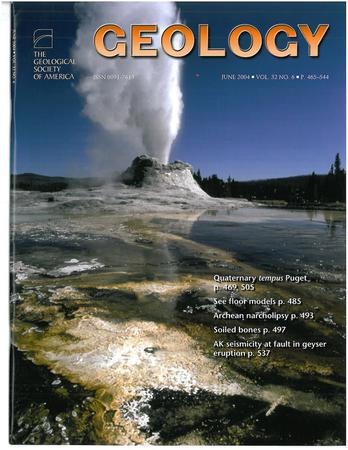Toroidal flow around the Tonga slab moved the Samoan plume during the Pliocene
IF 4.6
1区 地球科学
Q1 GEOLOGY
引用次数: 0
Abstract
Age-progressive seamount tracks generated by lithospheric motion over a stationary mantle plume have long been used to reconstruct absolute plate motion (APM) models. However, the basis of these models requires the plumes to move significantly slower than the overriding lithosphere. When a plume interacts with a convergent or divergent plate boundary, it is often deflected within the strong local mantle flow fields associated with such regimes. Here, we examined the age progression and geometry of the Samoa hotspot track, focusing on lava flow samples dredged from the deep flanks of seamounts in order to best reconstruct when a given seamount was overlying the mantle plume (i.e., during the shield-building stage). The Samoan seamounts display an apparent local plate velocity of 7.8 cm/yr from 0 to 9 Ma, 11.1 cm/yr from 9 to 14 Ma, and 5.6 cm/yr from 14 to 24 Ma. Current fixed and mobile hotspot Pacific APM models cannot reproduce the geometry of the Samoa seamount track if a long-term fixed hotspot location, currently beneath the active Vailulu’u Seamount, is assumed. Rather, reconstruction of the eruptive locations of the Samoan seamounts using APM models indicates that the surface expression of the plume migrated ∼2° northward in the Pliocene. Large-scale mantle flow beneath the Pacific Ocean Basin cannot explain this plume migration. Instead, the best explanation is that toroidal flow fields—generated by westward migration of the Tonga Trench and associated slab rollback—have deflected the conduit northward over the past 2−3 m.y. These observations provide novel constraints on the ways in which plume-trench interactions can alter hotspot track geometries.汤加板块周围的环状流在上新世期间移动了萨摩亚羽流
长期以来,人们一直利用岩石圈在静止的地幔羽流上运动所产生的年龄递增海山轨迹来重建绝对板块运动(APM)模型。然而,这些模型的基础要求地幔羽流的运动速度明显慢于覆盖岩石圈的速度。当羽流与辐合或发散板块边界相互作用时,它通常会在与这些机制相关的强局部地幔流场中发生偏转。在这里,我们研究了萨摩亚热点轨道的年龄演化和几何形状,重点是从海山深侧挖出的熔岩流样本,以便最好地重建特定海山何时覆盖地幔羽流(即在盾牌形成阶段)。萨摩亚海山的表观板块速度在 0 至 9 Ma 为 7.8 厘米/年,9 至 14 Ma 为 11.1 厘米/年,14 至 24 Ma 为 5.6 厘米/年。如果假定一个长期固定的热点位置(目前在活跃的维鲁鲁海山之下),那么目前的太平洋固定和移动热点APM模型就无法再现萨摩亚海山轨道的几何形状。相反,利用 APM 模型重建萨摩亚海山的喷发位置表明,羽流的表面表达在上新世向北迁移了 2°。太平洋海盆下的大规模地幔流动无法解释这种羽流迁移。相反,最好的解释是汤加海沟西移和相关的板块回滚产生的环状流场在过去2-3 m.y.使导管向北偏转。
本文章由计算机程序翻译,如有差异,请以英文原文为准。
求助全文
约1分钟内获得全文
求助全文
来源期刊

Geology
地学-地质学
CiteScore
10.00
自引率
3.40%
发文量
228
审稿时长
6.2 months
期刊介绍:
Published since 1973, Geology features rapid publication of about 23 refereed short (four-page) papers each month. Articles cover all earth-science disciplines and include new investigations and provocative topics. Professional geologists and university-level students in the earth sciences use this widely read journal to keep up with scientific research trends. The online forum section facilitates author-reader dialog. Includes color and occasional large-format illustrations on oversized loose inserts.
 求助内容:
求助内容: 应助结果提醒方式:
应助结果提醒方式:


